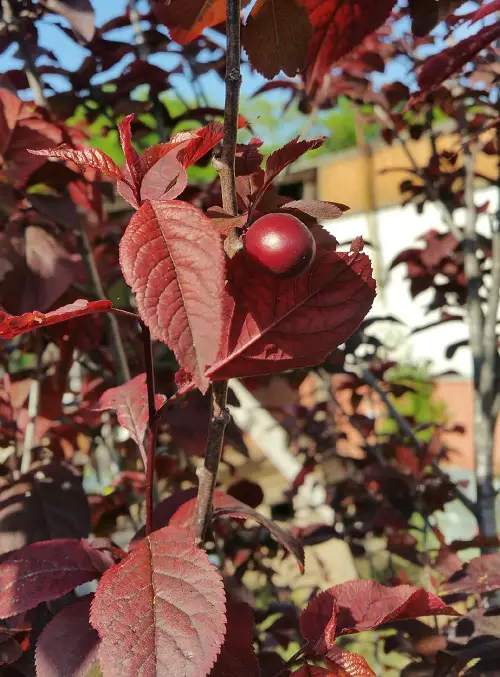Delicious fruits vs pretty vegetation? Do you want both? Check out our selection of Fruits With Beautiful Foliage!
Fruits often take center stage thanks to how quickly they appease our taste buds. But what about food for our eyes? It’s simple: grow these fruits with beautiful foliage, and you’ll get two things: a delicious homegrown harvest and a display of decorative leaves.
Fruits with Beautiful Foliage
1. Purple-leaf Plum
Botanical Name: Prunus cerasifera
USDA Zones: 5-8
Sporting leaves in deep burgundy and purple, this maple tree lookalike is treasured more for its deep-hued foliage and showy white flowers than its sweet and tart juicy fruits! Providing sharp contrast in gardens and landscapes, this deciduous tree presents richer colors in full sun and needs regular watering in its early days.
2. Papaya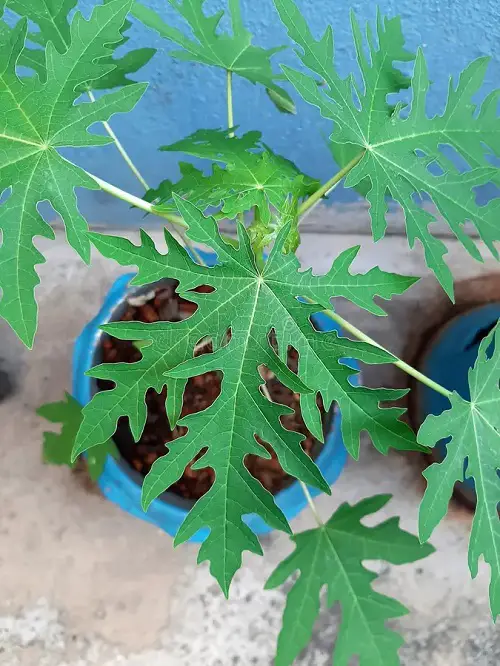
Botanical Name: Carica papaya
USDA Zones: 9-12
The nutritious, orange-fleshed papaya fruit needs no introduction. But we love it for its large, lobed green leaves with slight yellow veins. This tropical, short-lived perennial thrives in warmth and full sun and prefers well-draining soil.
Just don’t sit directly under one, or a ripe fruit may bonk you on the head!
3. Banana
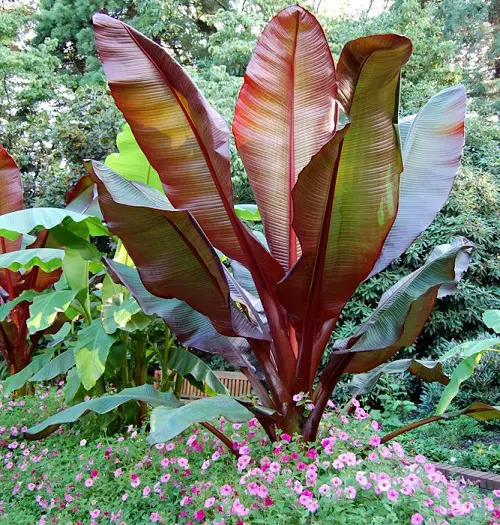
Botanical Name: Musa
USDA Zones: 7-11
Bananas have bright and colossal fan-shaped waxy leaves off which dew drops roll—the stuff of tropical dreams that people admire! But when its nectar-filled purple pendulous blooms appear and hands of fruit cluster, this herb tree is truly a sight to behold.
In several countries, banana leaves are often used as plates for eating.
4. Fig

Botanical Name: Ficus carica
USDA Zones: 7-11
This Mediterranean native produces purplish tear-dropped fruits with sweet fibrous flesh and crunchy seeds during late summer and early fall. Also a foliage treasure, fig leaves are large, green, and have 3-5 deep lobes. These leaves are rough and hairy on the surface and pale smooth below.
Funnily, its blooms are inverted and inside the fruit. Here’s how to grow your own.
5. Grapes
Botanical Name: Vitis vinifera
USDA Zones: 6-11
No scene of opulence has ever been complete without these gem-like fruits! But a grapevine’s foliage is a classic stunner all by itself. These lush climbers have large, deeply lobed, serrated green leaves that range from heart-shaped to ovate–perfect for a dense ornamental canopy. They need trellises and arbors to support themselves and grow.
If you happen to spot pretty red leaves on your grapevine, don’t be deceived, as this is a sign of biotic and abiotic stresses.
6. Black Guava
Botanical Name: Psidium guajava
USDA Zones: 9-11
Despite its delicious, vitamin C-rich, aromatic fruits, the guava tree, including this black cultivar, is also grown as bonsai, thanks to its picture-perfect form and foliage. The leaves are dark, metallic purple-green, with prominent veins on the underside.
Guava trees flourish in full sun, well-draining soil, and consistent watering.
7. Passion Fruit

Botanical Name: Passiflora edulis
USDA Zones: 9-11
Passion fruits have the prettiest evergreen foliage with deep green leaves shaped like tridents. Blooming at regular intervals throughout the year in warm, tropical climes, it produces large showy flowers that are totally unique.
Overall, this vigorous climber scores high in terms of flowers, foliage, and fruits, making it a perfect addition to garden fences, trellises, and climbing structures.
8. Dragon Fruit
Botanical Name: Selenicereus undatus
USDA Zones: 8-11
You’ll forget all about the bizarre and crunchy dragon fruit once you see its slender, succulent, bluish-green cascading stems. This unique climbing cactus uses aerial roots to cling to structures like trellises and poles and produces sweet-scented nocturnal blooms that attract night pollinators like bats and moths. And these blooms last only a day!
9. Date Palm 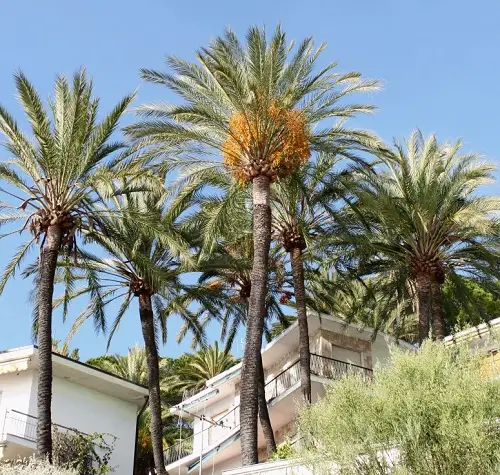
Botanical Name: Phoenix dactylifera
USDA Zones: 9-11
Here’s a tree with fruits and beautiful foliage—the date palm. Its fountain-like foliage spills from the crown of its thick, upright trunk, which is adorned with diamond-shaped leaf scars from where old fronds once grew. Sometimes, taking up to a decade to produce their sweet, sticky fruits. Date palms are long-lived trees, thriving for decades but you can only grow them if you live in a hot, arid climate.
10. False Almond

Botanical Name: Terminalia catappa
USDA Zones: 10-11
False Almond, or the Indian Almond, is a large tropical tree with broad egg-shaped leaves and edible seeds. Its leaves are slightly leathery to the touch and vary in color according to the time of year—as they mature, their green leaves turn red, yellow, and purple before falling.
11. Hardy Kiwi
Botanical Name: Actinidia arguta
USDA Zones: 3-9
This perennial woody vine bears fruits that closely resemble a regular kiwi but are tiny, hairless, and can be eaten with the skin. This vigorous grower has glossy, bright green heart-shaped leaves that turn yellow in summer and delicate, sweet-scented creamy flowers in spring.
In its natural moist temperate habitats, it can reach lengths of 100 feet, but in a garden, it usually maxes out at about 30 feet, as long as it gets ample sunlight.
12. Chocolate Vine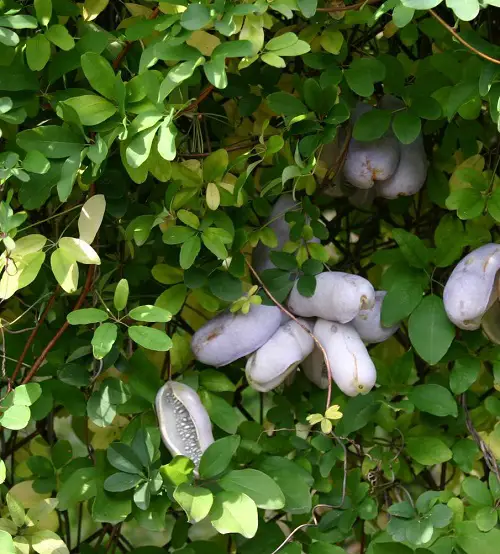
Botanical Name: Akebia quinata
USDA Zones: 5-8
Its chocolate brown flowers release a chocolate-flavored scent–hence the name! Also called the five-leaf akebia, this deciduous climber has five oblong leaflets that form a single leaf. It produces purple, cucumber-shaped edible fruits that split open in fall to reveal white, sweet flesh. Its blooms are reddish brown and cup-shaped, appearing late spring.
Regularly prune this wild grower and keep it in shape to truly relish its caramel charm!
13. Redbud
Botanical Name: Cercis canadensis
USDA Zones: 4-9
Did you know that this incredible tree produces flowers, leaves, and pods that are all edible and beautiful? Its heart-shaped leaves and the burst of pink blooms will all have you smitten! The fruits are a bit dull with their dried pea pod form, but the leaves more than makeup for this loss, with their pretty green that turns a bright gold during fall.
This easy grower thrives in various conditions, including full sun or part shade and moderately fertile clay or sandy soil, but it does not like drought-like soil conditions.
14. Prairifire Crabapple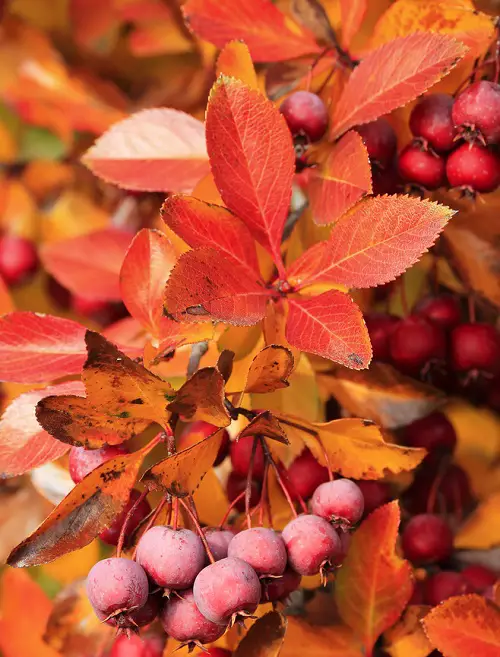
Botanical Name: Malus ioensis
USDA Zones: 4-8
Like a chameleon, Prairifire Crabapple’s foliage changes colors through the seasons. During spring, the leaves are a maroonish-purple and later change to a dark green with prominent red veins. And during fall, the foliage turns a golden bronze before shedding, just to start the cycle again next spring.
The foilage completely outshines its high-maintenance fruits that resemble tiny apples and appear in fall.


